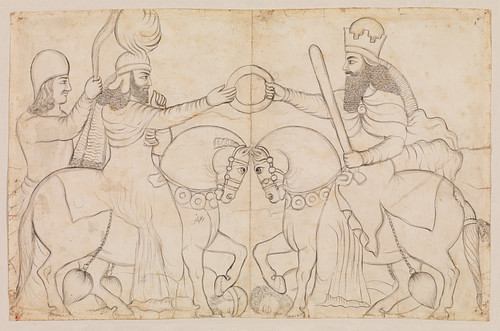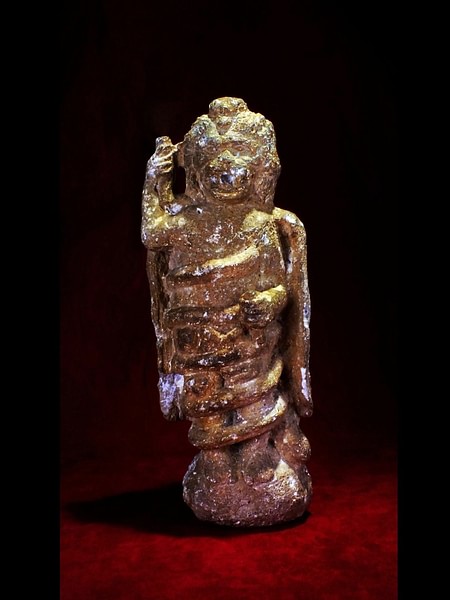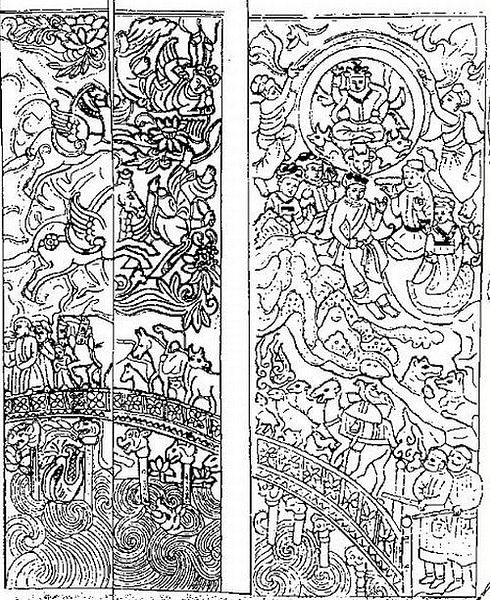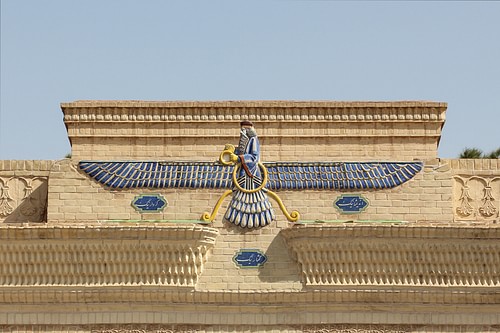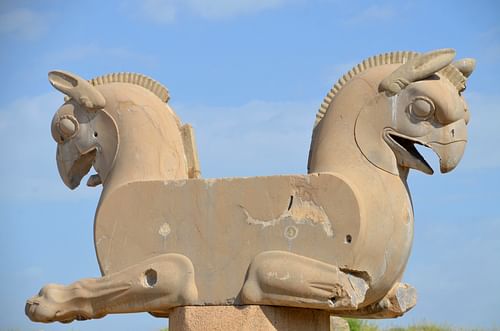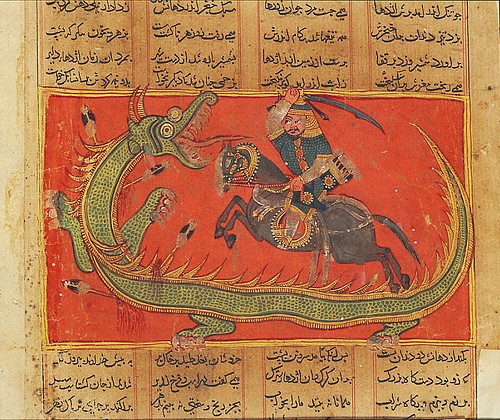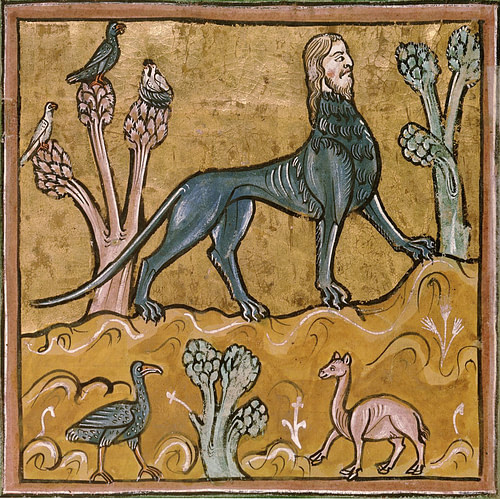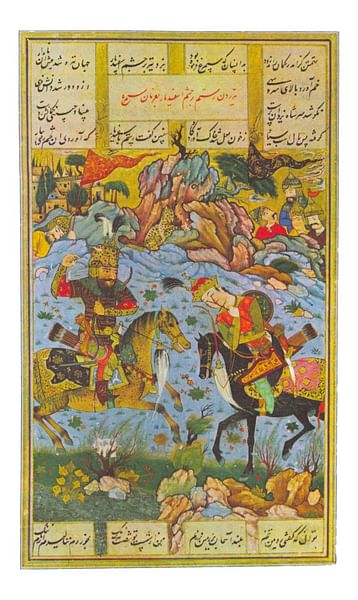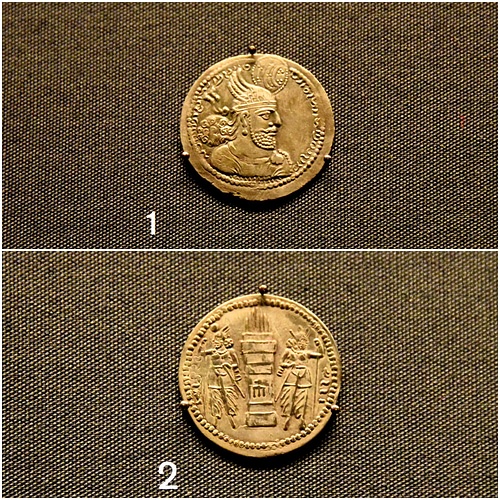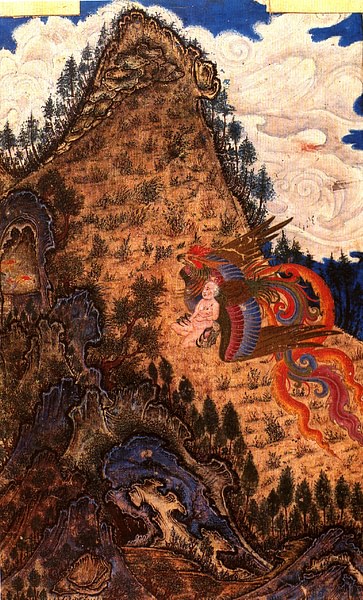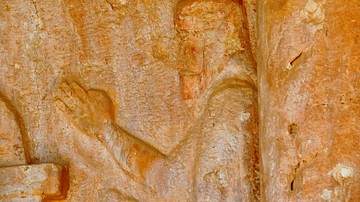The term 'mythology' comes from the Greek mythos (story-of-the-people) and logos (word or speech), meaning the spoken story of a people. Every civilization of the ancient world developed a belief system, which is characterized as 'mythology' in the present day but which, for them, was religious belief, and this was as true for ancient Persia as for any other.
These systems only became designated as “mythological” after they had been replaced by others which, even so, continued to express the same values emphasizing the forces of good and order over those of evil and chaos.
Oral tradition was especially important and storytelling a central value in ancient Persian culture, and so the stories of the old continued to be told, and many of the deities, now reimagined, appear in the works of the oldest monotheistic religion, Zoroastrianism, which developed between c. 1500-1000 BCE. This faith developed from an earlier polytheistic system featuring a pantheon of gods, led by their king Ahura Mazda, who stood against the forces of the evil spirit Angra Mainyu. The prophet Zoroaster revised this earlier vision so that Ahura Mazda became the one true god while the most significant of the other deities became emanations and manifestations of his eternal goodness.

The stories which had once made up the religious understanding of the people now became fables – myths – which entertained while also encouraging the same cultural values they always had, only now in a monotheistic context. The god Mithra might still be invoked and his battle with the dragon Azhi Dahaka still be told, but it was understood that Mithra was now simply Ahura Mazda fighting the forces of evil.
Many of the other gods of the original Early Iranian Religion were forgotten, however, and are only known through brief reference in Zoroastrian scripture, religious literature, and the tales collected and written down in works such as the Shahnameh and One Thousand Nights and a Night. Since ancient Iran/Persia maintained an oral tradition until the Sassanian Period (224-651 CE), there is no ancient text along the lines of Hesiod's Theogony or Homer's Iliad and Odyssey (both c. 8th century BCE) describing and defining the old gods at the time they were being worshipped. Inscriptions found in the ruins of cities like Susa or at the great temple of Chogha Zanbil (also known as Dur Untush) provide only the most basic allusions to deities predating the development of Zoroastrianism.
The gods, creatures, and heroes who made up these early stories of ancient Persian mythology are therefore scattered amongst the various works of Zoroastrianism and later collections of myth and fable. A comprehensive list, or at least an attempt at one, should therefore prove useful to anyone interested in the subject of Persian mythology and religion specifically or the study of myth, folklore, and religion generally.
The following is a list of the various entities of pre-Zoroastrian Persia who appear in some of the most famous myths and legends. The list attempts to be complete but will omit some minor deities and even some heroes whose qualities are represented by others more famous. The list will also include religious concepts and places considered important in ancient Persian religion, such as the Chinvat Bridge which souls crossed from life to death or the House of Song, the Persian vision of paradise. The following are all drawn from the sources listed below in the bibliography.
Index
A B C D E F G H I J K L M N O P Q R S T U W Y Z
A
Aeshma – a demon of cruelty who inspires brutality; later re-imagined as one of the archangels.
Aesma (Aesma-Daeva) – demon of lust and rage whose name means 'Fury'. Thought to be the inspiration for the Judeo-Christian demon Asmodaeus featured in the biblical Book of Tobit. Aesma was thought to be responsible for attacks on livestock, especially cows.
Agas – demon of illness, especially of the eyes. Her name means “evil eye”.
Ahura Mazda – king of the gods. His name means “Lord of Wisdom”. He was the supreme creator, maker of heaven, earth, animals, humans, and the sacred elements of air, water, earth, and fire which allowed creation to function. His archenemy was Angra Mainyu, spirit of evil and disorder. After Zoroastrianism's development, he became the only god of the new faith; later known as Ormuzd and Hormuzd.
Ahurani – wife or daughter of Ahura Mazda, goddess of waters, health, healing energies, wealth, and personal growth/development. Her name means “Belonging to Ahura” and, as ahuranis, is also used in reference to divine spirits (ahuras) who fight against evil forces and protect humanity.
Ahuras – divine spirits of light, emanations of Ahura Mazda, protectors and defenders of humanity; also known as ahuranis. Their enemies are the daevas, evil spirits of darkness.
Airyaman – god of friendship, healing, reconciliation.
Airyaneum Vaejah – also known as Eranvej, the center of the world; the ancient Iranian homeland first ruled by the just king Yima who was favored by the gods before he fell from grace. Outside of mythology, referenced as Ariana/Iran, “land of the Aryans”. It was the first of the seven regions created by Ahura Mazda.
Aka Manah – daeva (evil spirit) of sensuality and desire; tempter of the prophet Zoroaster who tried to seduce him away from devotion to Ahura Mazda.
Al (Hal) – nocturnal predator demons who fed on newborns and could harm or kill women in late-stage pregnancies. They were depicted as old women with long, stringy hair, sharp teeth, and talons. They were a specific type of a larger group of nocturnal predator demons known as Umm Naush.
Alburz (Mount Hara, Mount Harburz, Hara Berezaiti) – the first mountain created in the world whose roots stretch down into the earth and whose peak touches the utmost sky. It took 800 years to grow and was the source of light and water in the world; light was thought to be reflected from it and water to come from its snow-caps before gathering in the primordial Vourukasha Sea from which all other waters then flowed. In the Zoroastrian text Vendidad, it is the mountain in the afterlife on the other side of the Chinvat Bridge, the span between the world of the living and the dead.
Allatum – goddess of the underworld in the earliest vision of the Persian afterlife; later replaced by King Yima (also given as King Yama), the first mortal king to have died.
Ameretat – goddess of immortality whose name means “life” or “living”. She is one of the seven Amesha Spentas and is also the patron goddess of plants and flowers. Her archenemy is Zarich, the demon of ageing.
Amesha Spentas – also known as yazatas, the Amesha Spentas are seven immortal beings worthy of worship who personify the highest values and greatest goods. Their name means “immortal spirits”. They are Armaiti (Devotion), Asha Vahishta (Truth/Righteousness), Haurvatat (Wholeness), Khshathra Vairya (Desirable Dominion), Vohu Manah (Good Purpose), Spenta Mainyu (Holy Spirit), Ameretat (Immortality). They were the first seven emanations of Ahura Mazda in his act of creation.
Anahita (Ardvi Sura Anahita) – goddess of health, healing, water, and wisdom. She was prayed to for protection and survival by soldiers prior to battle and so is also considered a goddess of war. Her name means “immaculate” and she is depicted as a beautiful young woman in a white gown brocaded with gold wearing a gold crown and carrying the sacred barsom twigs which represented the earth; sometimes also shown with a water pitcher. She was closely associated with the god Mithra and her sacred animals were the dove and peacock. She was among the most popular deities of the pantheon and was retained as a divine emanation in Zoroastrianism.
Angra Mainyu – the chief of the dark spirits of evil and chaos. His name means “evil spirit”, and he is the archenemy of Ahura Mazda and the forces of light. For every good that Ahura Mazda brings into the world, Angra Mainyu finds some way to corrupt or destroy it, and yet Ahura Mazda turns his efforts to positive ends, constantly thwarting his attempts to subvert order and establish chaos. He is also known as Ahriman, especially in later texts on Zorvanism, where he is referenced as Ahura Mazda's twin brother. He is eventually defeated and destroyed by Ahura Mazda at the end of the world.
Apam-Napat – a water god whose name means “child of the waters”. He is the son of the water god Vouru-Kasa, keeper of the waters, who gives water to humans.
Apaosha – demon of drought who rides a black horse, he is the enemy of the rain god Tishtrya who eventually defeats him.
Arash – the archer, great hero who fired his arrow to mark the boundary between Iran and Turan. The effort of firing his great bow such a long distance killed him, but his spirit remains and continues to encourage others, especially those who are in danger of losing their way.
Ariana – possibly a mother goddess, personification of the ancient land of Iran, though poorly attested.
Arishtat (Arshtat) – god of honesty who encourages decency, fairness, and justice.
Armaiti (Spenta Armaiti) – goddess of devotion, daughter of Ahura Mazda, one of the seven Amesha Spentas. Her name means “beneficent devotion”, and she is also associated with the earth and the newly dead as one was expected to show devotion to one's home and to those who had passed from it. Also known as Sepandarmaz who inspires the day of devotion to women celebrated annually in Iran as Sepandarmazgan (also given as espandegan).
Asha Vahishta – god of Truth/Righteousness, one of the seven Amesha Spentas. His name means “excellent order” or “outstanding truth”, and he stands in opposition to the forces of darkness and lies.
Ashozushta – the great owl who flies at demons and scares them away as it recites holy words and phrases. Associated with, but not the same as, the Huma Bird.
Ashi – goddess of conscience.
Asman – a god of the sky.
Asto Vidatu – the demon of death who, not content with killing a person, then tries to snatch their souls into hell as they cross the Chinvat Bridge after their passing. Along with the demon Aesma Daeva, he waits to catch souls with a rope and pull them from the bridge, but justified souls are protected by the angel Suroosh and comforted by the Holy Maiden, Daena. Associated with, and possibly the same demon, as Vizaresha.
Atar – the god of fire who is also the personification of fire and physically present when fires are lighted. He is associated with light, righteousness, and purity.
Az – demon of lust and greed, one of the more dangerous (female) drujs.
Azhdaha – dragons, generally; large snakes who prey on people and livestock and are the regular adversaries of the great heroes.
Azhi Dahaka – the great three-headed dragon created from the lies of Angra Mainyu to corrupt order and thwart the best impulses of the world. He has a thousand senses and is invincible but, embodied as the tyrant Zahak, was defeated by the hero Thraetaona (Fereydun) who keeps him in chains until the end of the world at which time he will be killed by the resurrected hero Karsasp.
B
Baga – god of wealth and good fortune.
Bahram – god of victory in life and after death, associated with the warrior god Verethragna. His name means “smiting of resistance”, and he epitomizes the concept of victory. On earth, he assists the righteous in their war against the forces of darkness; after death, he helps protect the justified soul on its journey to paradise.
Barmayeh – the great cow of the Alburz Mountains who nurses the hero Fereydun and cares for him.
Bushyasta – demon of sloth who causes people to slip toward the forces of darkness as he makes them too lazy to resist comfort and commit to fighting for truth.
Buyasta – demon of laziness who prevents people from doing what they should.
C
Cats – although there is myth associating the creation of the cat with the hero Rustum, cats were generally regarded with suspicion or outright fear because they were associated with the physical manifestation of the demons known as khrafstra who appeared as frogs, lizards, wasps, but also as animals such as lions and tigers. The dog was considered the best protection against these demons and also warded off cats.
Chamrosh – a giant bird with a dog's body and the head and wings of an eagle. It lives beneath the Tree of All Seeds and, when the great bird Saena-Simurgh – living high in the trees' branches – flaps her wings, the seeds scatter and Chamorsh distributes them into the wind and rain to fall across the earth. Chamrosh is also a protective entity, who swoops down upon non-Iranian invaders, pecking at them and driving them away.
Chinvat Bridge – the span between the world of the living and the land of the dead. After a person died, the soul lingered by the corpse for three days while the gods considered their ultimate fate and tallied up their good and bad deeds. On the fourth day, the soul traveled to the Chinvat Bridge where it was met by the Holy Maiden Daena who would comfort it. The soul would then cross the bridge – which became broad and easy for the justified but narrow and difficult for the condemned soul. Souls were protected from demonic attack by the angel Suroosh and were threatened by the demons Asto Vidatu and Aesma Daeva. At the end of the bridge, the angel Rashnu would judge the soul based on its deeds in life and assign it a fitting home in the afterlife, either the House of Song (paradise) or the House of Lies (hell).
Cista - an early goddess of health and well-being who presided over one's path in life and also one's spiritual walk of faith. She was a companion of Mithra. Her name is translated to mean "to understand" or "to notice" and she inspired people to recognize the path they were on, change it if they were going wrong, and continue on with strength and perseverance if they were doing right (essentially, the personification of one's conscience). She was later replaced by Daena who welcomed or rebuked souls arriving at the Chinvat Bridge
D
Daena – the Holy Maiden who appears to the newly deceased on the Chinvat Bridge and comforts them as they cross. She is the personification of one's conscience and, as such, to the justified soul she appears as a beautiful maiden while, to the condemned, she is an ugly and frightening old hag. She is sometimes referenced as the daughter of Ahura Mazda and Armaiti, combining wisdom and devotion, and so symbolizes the heart of religious belief. She is the later form of the earlier goddess Cista but with significant modifications such as her pivotal role at the Chinvat Bridge.
Daevas – the mostly male demons in the service of Angra Mainyu who spread lies and disorder in the world. They are the sworn enemies of the Amesha Spentas and all that is good and work closely with the drujs who are mostly female demons.
Dev – demon of war and the terror of war, one of the most powerful daevas, completely lacking in morality or compassion.
Din – goddess of forgiveness
Dogs – dogs feature prominently in Persian mythology as forces for good. Two dogs guard the Chinvat Bridge and welcome justified souls while rebuking those who lived according to lies. Dog imagery also appears in depictions of the great birds Simurgh (known as the dog-bird) and Chamrosh. The four-eyed dog – a dog with a spot above each eye – was considered especially potent protection against evil spirits.
Drug (Druj) – an evil demon who is the personification of the lie
Drvaspa – goddess of cattle, children, and friendship, who promotes harmony.
Duzhyairya – demon of want, who causes bad harvests; archenemy of Tishtrya, god of rain.
E
Eranvej – the Pahlavi name for Airyaneum Vaejah, the center of the world.
F
Faravahar – the famous Persian symbol of a royal figure seated on a solar disc in the center of outstretched wings, usually interpreted as representing divine grace and higher powers.
Fereydun (Feridun) – another name for the great Persian hero-king Thraetaona, who defeats the evil dragon Azhi Dahaka, liberates the people from Zahak (the dragon's embodiment), and was father of the princes who wage the Iranian-Tauranian War in the Shahnameh.
Fravashis – guardian angels, an aspect of one's higher self. At birth, the fravashi sends the soul (urvan) into the physical body so that it can contribute to the fight against evil and experience the material world. At death, after three days, the urvan is reunited with the fravashi who assists it in crossing the Chinvat Bridge. The image of the faravahar is often associated with the fravashi as higher entities.
G
Gandareva (Gandarewa) – a water demon in the form of a great dragon who churned the seas, sank ships, and came ashore to devour people, cattle, and homes. Known as the “golden-heeled”, he was finally defeated and killed by the hero Karsasp. Gandareva is said to guard the sacred haoma plant and tried to keep it and its many benefits for himself.
Gaokerena – the healing and life-giving haoma plant which grew nearby the Tree of All Seeds in the center of the Vourukasha Sea. It restored health when eaten and its juice granted vision and immortality to the resurrected dead. The evil demons known as khrafstra tried to kill it, taking on the form of a frog and a lizard to eat it, but the plant was protected by the Kara fish who swam around it and kept them away as well as by the Righteous Ass, a pure-white donkey with a single golden horn on his forehead, three legs, nine mouths, and six eyes.
Garshasp – another name for the monster-slaying hero Karsasp/Keresaspa.
Gavaevodata – the Primordial Bull (also known as the Uniquely Created Bull, Primordial Bovine, Primordial Ox), the first unique creature made by Ahura Mazda after the creation of sky, water, earth, and vegetation. Gavaevodata, an androgyne, was so beautiful that Angra Mainyu killed it but Ahura Mazda purified the bull's seed and, from this, came all other animals on earth.
Gaya Maretan – the first king of the Iranians (in some legends) who established law in the land and initiated civilization. His grandson, Haoshyangha (Hushang), would later rework Gaya Maretan's early efforts and be known as the lawgiver.
Gayomartan – the first man created by Ahura Mazda who, like Gavaevodata, was so beautiful he was killed by Angra Mainyu. His seed was purified by the sun and engendered a rhubarb plant which later gave birth to the first mortal couple Mashya and Mashyanag, progenitors of all other humans.
Geus-Tasan – god of cattle and their creator.
Geus-Urvani – god of cattle and their protector.
H
Hadhayans - the celestial bull. It was said to be so large it could easily stride the seven regions of the earth and people could climb on its back to travel from one place to another. It was later re-imagined as the bull Srisok who brought the holy ritual fires to earth which had been first kindled by Ahura Mazda.
Haftorang (Hastorang) – one of the Four Royal Stars (modern designation Fomalhaut) which worked for good in the cause of Ahura Mazda. Guardian of the winter solstice. Known as the Watcher of the South.
Haoma – god of the harvest, health, strength, and vitality; personification of the haoma plant whose juices brought enlightenment and of which Gaokerena was the greatest and largest.
Haoshyangha (Hushang) – the grandson of the first mortal king, Gaya Maretan, and known as the great lawgiver who established civilization including agriculture. In some myths, he is the first king, in others Yima (Yama) is the first king and, in still others, Gaya Maretan and Haoshyangha follows after.
Hara Berezaiti (Alburz, Mount Hara, Haburz) - the first mountain whose name means "high watchtower", in the Vendidad, it is the mountain on the far side of the crossing between the land of the living and the dead, the Chinvat Bridge. It is considered the first mountain from which all others came and the source of water and light.
Haurvatat – goddess of wholeness, completeness, perfection and so associated with prosperity, wealth, and health. One of the seven Amesha Spentas. Her archenemy is the demon of hunger, need, and want, Tawrich.
House of Lies – the dark abode of the dead, a hell in which the condemned soul was tormented while simultaneously feeling completely alone. There were four levels descending down from the Chinvat Bridge, each one increasing in darkness until the lowest which was completely absent of all light. Souls sentenced to the House of Lies were those who had followed and worked for the forces of darkness but, even so, they would not remain there eternally and would eventually be reunited with Ahura Mazda.
House of Song – the bright realm of paradise after death where the justified souls who had served Ahura Mazda were welcomed. There were four levels ascending upwards from the Chinvat Bridge, where judgment was given, each brighter and lovelier than the last until one reached the highest heaven where the soul would live in the direct light of Ahura Mazda.
Huma Bird – a mystical bird who lived an exceptionally long life before dying in its own flames and rising again like the Phoenix. It flew over the earth constantly, never landing, and it was thought that if its shadow passed over a person it would bring good fortune (in some versions, the shadow would predict future kingship). Injuring, or attempting to injure, the Huma Bird would bring a lifetime of bad luck. It is associated with the great bird Simurgh, although they may not be the same, and is most likely the bird depicted in sculpture at Persepolis.
Hushedar – the first of three saviors to appear before the end of the world. When Hushedar appeared, people would stop eating meat and the sun would stand still for ten days. Hushedar was followed by Hushedar-mar and then by Saoshyant, the final messiah (whose name means “One Who Brings Benefit”), who would bring the end of the world and reconciliation with Ahura Mazda.
Hushedar-mar – the second of three saviors to appear before the end of the world. When Hushedar-mar appeared, people would stop drinking milk and the sun would stand still for twenty days. Hushedar-mar would continue the work begun by Hushedar, but this would be interrupted by the demonic dragon Azhi Daraka who would break his chains and wreak havoc on the world before his defeat and death, which would signal the coming of the last messiah, the Saoshyant.
Hvar Ksata (Hvare Khshaeta) – god of the full sun, the “many-horsed god” who drives his chariot across the sky throughout the day. His name means “radiant sun”. He was later replaced by Mithra.
I
Indar – the early god of courage, bravery, heroism, and warfare.
Indra – the demon of apostasy who encouraged the abandonment of religious practice and true faith.
Izha – goddess of sacrifice. Her name means “offering” and she presided over and encouraged sacrifice to the gods.
J
Jahi (Jeh) – female demon of lasciviousness referenced as “the Whore” who defiles altars and corrupts women. She is also associated with causing women's menstrual cycle but, as this is also said to have been instituted by Ahura Mazda and a natural occurrence, it is more likely she causes painful or difficult periods. She was the agent through whom Angra Mainyu killed the Primordial Bull Gavaevodata and is among Ahura Mazda's greatest enemies.
Jamshid (Jam, Yima Kshaeta) – the fourth king of the world who brought civilization to its greatest height, initiated the construction of cities, established social hierarchy, and introduced winemaking. According to one part of his legend, Jamshid banished a woman of his harem who, in attempting to commit suicide afterwards, drank a bottle of fermented grape juice thinking it was poison. When she found it produced pleasing sensations, she brought the rest to Jamshid who reinstated her and decreed that grapes should be used in making wine.
Jinn (Djinn) – supernatural entities, neither immortal nor human spirits, who are better known as genies. They were neutral in the war between the forces of Good and those of Evil and based their actions on circumstance rather than ideology. When a human encountered a jinn, the entity might grant the person's wishes or trick them at the last moment. They were generally regarded with suspicion, and amulets were carried by merchants and travelers for protection against them. Jinn were thought to inhabit lonely places outside of established communities and were especially to be feared when crossing the desert and in stops at oases.
K
Karmak – the giant bird of evil so large that its wings blot out the sky and prevent rain from falling, thereby bringing drought to the land. Karmak is the evil counterpart of the bird Chamrosh who spreads seeds, encourages fertility, and protects the people of the land. Karmak continuously fed on human beings and livestock until killed by the hero Karsasp who showered it with arrows.
Kara Fish – fish that protect the Tree of Seeds and the plant Gaokerena in the middle of the Vourukasha Sea. The Kara fish swim constantly around these in order to drive away evil spirits who try to destroy them.
Karkadann – a horned beast similar to a unicorn. Like the unicorn, the karkadann could be tamed by a virgin. It lived in remote places and the sight of it was thought to bring good luck. Its horn was said to have healing powers.
Karsasp (Keresaspa, Garshasp) – the great hero who defeated Gandareva, Karmak, and engaged in many other adventures. He will be resurrected in the final days to slay the dragon Azhi Dahaka.
Karshiptar (Karshipta) – the swiftly flying giant bird who spreads the truth of Ahura Mazda around the world; later said to have spread Zoroaster's vision of Ahura Mazda as the one true god which enabled the faith to reach so many people and take hold.
Kaveh (Kawa, Kaveh the Blacksmith) – the blacksmith in the Shahnameh who incites rebellion against the ruthless tyrant Zahak by lifting his blacksmith's apron on a spear. He inspires the hero Fereydun to lead the revolt.
Kay Khosrow – son of the hero Siyavash and warrior-king in the Shahnameh who avenges his father's death and rules justly after restoring order. He has a magic cup used in divination which was thought to contain the elixir of immortality.
Khrafstra – evil demons who manifest themselves physically in the form of frogs, lizards, wasps, annoying insects such as stinging ants, and beasts of prey. They were invisible unless they wanted to be seen. The Al (Hal) is the most feared of these demons as it preyed upon newborns and sleeping mothers and their children.
Khshathra Vairya – god of the desirable dominion (Kingdom of Heaven, paradise) who enables people to resist the lies of Angra Mainyu and fight against evil. He is depicted with a helmet, shield, and spear and is associated with metal and metallurgy, especially with molten brass, thus linking him with transformation. He is one of the Amesha Spentas and a powerful opponent against the forces of evil. He protects paradise but also enables human souls to attain it.
Khurshid – an angel of the sun, associated with light.
Khvarenah – “divine glory” – the force which enables a person to perform the function they are supposed to in life, synonymous with farr (“divine grace”) which legitimized the reign of a king. The force equated with “fortune” or “destiny” which defined a person's role in life.
M
Mah (Mangha, Maha) – goddess of the moon who accepted the corpse of Gavaevodata and purified its seed so that animals could be created.
Manticore – “man-eater”, a monster with the head of a man, body of a lion, and tail of a scorpion who devoured people whole, leaving no trace of them except – sometimes – spatters of blood. It was thought to live in lonely places outside of communities, could kill anything except elephants, and was invincible because its hide was so thick. It struck without warning but, sometimes, would announce itself with a growl like a trumpet.
Mao – god of the moon in some works although it is more common to find Mah referenced as female deity of the moon.
Mithra – one of the most popular and best-known gods of the Persian pantheon, Mithra was the god of the rising sun, covenants, and contracts and is therefore also associated with friendship. He was also responsible for maintaining cosmic order and regulating the change of the seasons at the proper times. He was also associated with the haoma plant, as its protector, linking him with enlightenment and guided the faithful toward Truth (Asha) while defending them against the wiles of the forces of darkness. Mithra is depicted riding in a great chariot drawn by white horses, armed with a silver spear, bow, and arrows of gold. He also carries daggers, throwing-axes, and his famous mace which is his most powerful weapon. The mace confers authority and so Mithra was also associated with farr (“divine grace”) which legitimized a king's rule. Mithra's heroic qualities formed the basis for the central figure of the Roman mystery religion known as the Cult of Mithras, but the two deities are not the same. The Roman Mithras was an astrological deity while the Persian Mithra was considerably more complex.
N
Nairyosangha – an angel associated with fire and, therefore, purity; Ahura Mazda's messenger who also carries the prayers of people from earth to heaven.
Nanghaithya – demon of discontent and ingratitude who whispers poisonous lies to people of what they should have or could have and so deprives them of gratitude for all the good things they do have. The archenemy of Spenta Armaiti, goddess of devotion, who encourages gratitude and thankfulness.
Nasu (Naush) – demon who contaminates corpses of the newly deceased in the form of a fly. She comes from the darkness of hell as soon as she hears someone has died and tries to contaminate the corpse before funerary rites are completed. She is scared off by a dog, especially the four-eyed dog (one with a spot above each eye), who is led into the room between three and nine times for this purpose. When the dog enters the room without hesitation and does not balk at approaching the corpse, Nasu is thought to have been driven away and mortuary rites may proceed.
Neriosang – an angel, messenger of the gods.
O
Ormuzd – another name for Ahura Mazda.
P
Pairaka (Pairi) – shapeshifting female demons (daeva) who appear as beautiful women to seduce and corrupt men in the night. They can also appear as rats, shooting stars, or in other forms.
Peri – a small, beautiful, winged female spirit better known as a faerie. Peris, like jinns, are considered neutral in the war between Good and Evil and, also like them, are as apt to trick a person as to deal fairly. They bring messages from the gods but might as easily fail to deliver them, or misspeak, as perform their task correctly. They are thought to be spirits imprisoned to atone for past sins but are neither immortal nor human souls.
R
Rakhsh – the great stallion of the hero Rustum, mightier and more intelligent than any other horse, and of amazing strength and speed. Only Rustum was able to ride Rakhsh as Rustum's superior strength and power would have killed any other horse, although Rakhsh would not allow any other rider through devotion to Rustum.
Rapithwin – god of the midday sun, guardian of the south, warm winds, and summer.
Rashnu – angel of judgment and divine judge of the dead at the Chinvat Bridge. In some versions, Rashnu reads from the scrolls relating the good and bad deeds done by the soul in life, in others he holds golden scales which weigh these deeds against each other to determine the soul's destination in the afterlife. He may have been later replaced by Mithra or, more likely, worked with Mithra in dispensing justice after death.
Righteous Ass – the white donkey with a golden horn protruding from its forehead with three legs, nine mouths, and six eyes who guards the Tree of All Seeds and the great haoma plant, Gaokerena, in the midst of the Vourukasha Sea.
Roc – the giant bird of prey best known from the stories concerning Sinbad the Sailor from One Thousand Nights and a Night.
Royal Stars – the four major stars which influenced or, at times, governed human events. Although the claim that the ancient Persians recognized these stars has been challenged, the Zoroastrian cosmological text Bundahisn, attests to such. The four stars were Tascheter (Aldebaran), Venant (Regulus), Satevis (Antares), and Haftorang (Fomalhaut). The stars worked for good on the side of Ahura Mazda; the planets were controlled by Angra Mainyu and attempted to corrupt or block the good influence of the stars.
Rudaabeh (Rudaba, Rudabeh) – a beautiful princess of Kabul in the Shahnameh, wife of the hero Zal, mother of the champion Rustum.
Rustum (Rostom, Rustam) – the great hero of the Shahnameh, grandson of King Sam, son of the hero Zal and the Princess Rudaabeh. Rustum is the greatest and best-known Persian champion, invincible in battle, who fights to maintain order and justice against the Kingdom of Turan. He is only finally killed through deceit but still is victorious in maintaining order against chaos.
S
Saena (Senmurv) – the great falcon who sits in the top branches of the Tree of All Seeds. When she flaps her wings, the seeds are scattered and carried away by the winds, with the help of the bird Chamrosh, to land in the earth. Associated with the great dog-bird Simurgh, although some scholars claim they are two distinct entities.
Saena Tree (Tree of All Remedies, Tree of All Seeds) – the great tree and “mother of all trees”, “mother of all plants” which grows in the middle of the Vourukasha Sea and sends the seeds of all vegetation out into the world when the Saena Bird, who lives in its branches, flaps its wings.
Sagdid – “glance of the dog”, the ritual in which a dog is led into the presence of the corpse of the newly deceased to drive away evil spirits, especially Nasu (Naush) who will corrupt the dead body and make it unclean. The dog is led in three times but, if it hesitates, can be led in as many as nine times to make sure all evil spirits have been dispersed.
Sam – great king and father of the hero Zal who abandons him in the Alburz mountains because he considers his fair hair a bad omen. Zal is raised by the dog-bird Simurgh and is later reconciled with his father. Sam is the grandfather of the great champion Rustum.
Satevis – one of the Four Royal Stars (modern designation Antares) who worked for the good on the part of Ahura Mazda. Governed the autumnal equinox; known as Watcher of the West.
Saurva – demon of chaos and one of the central Daevas, archenemy of the Amesha Spenta Khshathra Vairya, protector of the desirable dominion of paradise.
Shahbaz – a giant bird, larger than any other, who watches over and encourages humanity; thought to be the Imperial Eagle representing royalty under the reign of Cyrus the Great.
Shabrang Behzad – the mighty black horse of the hero Siyavash.
Shahrazad (Scheherazade) – heroine of the One Thousand Nights and a Night who is married to the king Shahriyar. Shahriyar adopts a policy of marrying a virgin, spending a night with her, and executing her the next morning. Shahrazad preserves her life by telling the king a story their first night together but not finishing it. Shahriyar allows her to live so he can hear the ending. She continues this pattern for one thousand and one nights and so saves herself.
Shahriyar (Shahryar) – the king in the One Thousand Nights and a Night who, upon finding out his wife was unfaithful, has her executed and then marries only virginal women, killing them the morning after the wedding night, before they have a chance to betray him. When he marries Shahrazad, she preserves her life by telling him a story the night of their wedding but not finishing it; to hear the conclusion, he lets her live, and so she continues telling her stories in the same way and escapes execution.
Simurgh – the “dog bird” who cares for the hero Zal after he is abandoned by his father Sam in the Shahnameh. Simurgh had the head of a dog, body of a peacock, and claws of a lion and lived 1,700 years, acquiring all knowledge, before dying in a flame of its own making and rising again. According to some interpretations, she is the later version of Saena; according to others, a distinct entity.
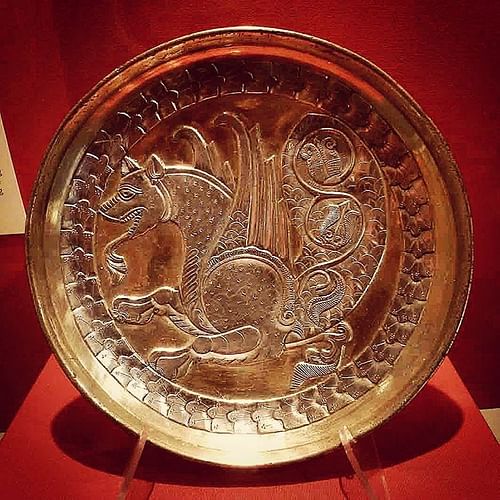
Siyavash – hero of the Shahnameh symbolizing virtue, innocence, integrity, and courage. Siyavash was the son of the king Kay Kavus and his favorite concubine who falsely accused the hero of raping her when he would not submit to her attempt at seduction. To prove his innocence, he rode his great horse Shabrang Behzed through a towering fire and emerged unscathed. Afterwards, he voluntarily exiled himself to the land of Turan where he was killed by the king Afragiab. His son, the great Kay Kosrow, later avenged him.
Sohrab – the tragic hero and son of Rustum and the princess Tahmineh in the Shahmaneh. Sohrab is born while Rustum is away at war and, when he is grown and has become a great warrior, goes to find him. Rustum and Sohrab meet in battle, neither knowing the other's identity, and Sohrab is killed.
Spenta Mainyu – “Holy Spirit”, one of the seven Amesha Spentas, the embodiment of the light and goodness of Ahura Mazda. In some passages, he is the twin brother of Angra Mainyu.
Sraosa (Sorush, Suroosh) – angel of the Chinvat Bridge who guides and protects souls of the newly deceased as they cross toward final judgment by Rashnu. Sraosa works with the Holy Maiden Daena and, like her, reflects the conscience of the soul after death.
Srosh – an angel, possibly the same as Sraosa/Suroosh, who announces the time of death of the king.
Srisok - the celestial bull known earlier as Hadhayans who brought the three sacred ritual Great Fires, kindled by Ahura Mazda, to earth. He was also known as Thrisaok (meaning "three burning places") as deliverer of the fires which stood against the forces of darkness and chaos.
T
Tahmineh – mother of the hero Sohrab in the Shahnameh. She spends a night with Rustum who gives her an armband to give their child. Sohrab grows up to become a great warrior and is given the armband so he can prove to Rustum he is his son when they meet but, when this happens, they are fighting on opposite sides and Rustum kills Sohrab before the armband is shown.
Tascheter – one of the Four Royal Stars (modern designation Aldebaran) who worked for the good forces of Ahura Mazda. Guardian of the vernal equinox. Known as the Watcher of the East.
Tawrich – demon of hunger, want, and need. Archenemy of the Amesha Spenta Haurvatat, goddess of wholeness.
Thraetaona – also known as Fereydun, the great hero-king of the Shahnameh who defeats the dragon Azhi Dahaka. He reigned for 300 years and then divided his kingdom between his sons Salm (West Asia, roughly), Tur (Central Asia, Kingdom of Turan), and Iraj (who received Iran). Iraj's portion was thought the best and so his brothers killed him for it. Thraetaona then installed Iraj's grandson Manuchehr in the throne of Iran. Manuchehr initiates the Iranian-Turanian War.
Tiri – god of agriculture associated closely with Tishtyra and sometimes given as his twin; poorly attested and possibly the same deity in an earlier form.
Tishtrya – god of rain and the harvest, sometimes given a twin, Tiri (god of agriculture). Tishtrya is represented as a white horse with golden ears, ornamented with gold trim, who battles the demons Apaosha (drought) and Duzhyairya (bad harvest), rising from the Vourukasha Sea, the source of all waters, to fly across the sky or dive into the waters to defeat his enemies. He derives strength from the proper worship of the people; fighting well when offerings are made in the right spirit and faltering when his worshipers neglect him.
Tistar – god of rain, possibly another form of Tishtyra but most likely a separate deity. Tistar came to earth three times bringing rain in such quantity it flooded the earth. He is, like Tishtrya, depicted as a white horse battling the demon Apaosha (shown as a black horse). His second flood creates the Vourukasha Sea, source of all waters.
Tushnamatay – goddess of thought and meditation.
U
Umm-Naush – nocturnal demonic predators who threatened human lives and cosmic order. The Umm-Naush were a subset of the evil spirits known as Khrafstra. The most feared among them were the Al (Hal) who preyed on newborns and their mothers.
V
Vayu (Vayu-Vatu, Vata) – god of the wind who lived between worlds, in the interface between the good of Ahura Mazda and the evil of Angra Mainyu and so could be a powerful force for either side. Vayu was considered a yazata (spirit worth worshipping) or a daeva (evil spirit) depending on how he sided at a given time. He is shown as a warrior with golden weapons, notably an impressive spear, charging against the forces of light or whirling about to destroy those of darkness. He was later recognized in the post-Zoroastrian movement of Zorvanism as god of limited space and time.
Venant (Vanant) – one of the Four Royal Stars (modern designation Regulus) who worked for the good under Ahura Mazda. Guardian of the summer solstice. Known as the Watcher of the North.
Verethragna – warrior god whose sole responsibility is to fight against evil. He is a shapeshifter and can appear as a bull with yellow ears and golden horns, a white horse with gold trappings, a mighty camel, a strong boar, a young man in fighting form at the age of 15 (considered the ideal age when a boy became a man), as a huge ram, an agile deer, a warrior wielding a golden sword, a strong wind, or a great bird. He is associated with Simurgh, the dog-bird, whose feathers could be used to invoke her in times of need. He was considered the greatest protection against evil.
Vizaresha - demon who drags souls into hell from the Chinvat Bridge, associated with the demons Asto Vidatu and Aesma Daeva. Also associated with the demon Nasu who contaminates dead bodies, flying from the north (location of hell) when it hears someone has died.
Vohu Manah – “good purpose”, one of the seven Amesha Spentas, represented on earth by domesticated animals, especially the cow. Vohu Manah encourages people to do the right thing under any circumstance. He is best known as the spirit of light who delivered the revelation of divine truth to Zoroaster on the banks of a river.
Vouru-Kasa – a water god who is the keeper and protector of the waters of the Vourukasha Sea, the source of all waters, and is the embodiment of that sea. He is the father of Apam-Natat, the god who provides these waters to humanity.
Vourukasha Sea – the primordial sea from which all other waters flow on earth. The waters are said to come from the Alburz Mountains through ice-melt and collect in the Vourukasha Sea and, from there, flow outwards to form all the other bodies of water in the world. The god Vouru-Kasa watches over, and embodies, the sea and his son, Apam-Natat, is responsible for dispersing the waters around the world.
Y
Yazatas – beneficial spirits worthy of worship. The Amesha Spentas are yazatas, as are angels and a number of other deities.
Yima (Yama) – the first mortal king to have ruled. He was favored by the gods and given supernatural powers. When the population grew too large, he enlarged the world and also saved the world when the gods informed him a bitter winter was coming and he enclosed animals, vegetation, and seeds in a giant barn (a tale preceding the biblical narrative of Noah and his Ark) to preserve life. He fell from divine grace when he began to think more highly of himself than he should have. Even so, for his virtuous service, he was made Lord of the Dead, and the afterlife was initially known as Yima's Realm.
Z
Zahak (Zohak) – the embodiment of the evil Azhi Dahaka. Zahak was a prince who was corrupted by the lies of Angra Mainyu, killed his father, and took the throne. He then overthrew the king Jamshid and established a tyranny over the world which lasted 1,000 years. He was overthrown by the hero Fereydun who restored order and justice.
Zal – “albino”, the white-haired hero born to the king Sam and father of the champion Rustum. His white hair was taken as an ill omen, and he was left abandoned on the slopes of the Alburz Mountain. He was adopted by Simurgh, the dog-bird, and raised as one of her own children, acquiring great strength and wisdom. Eventually, tales of a great hero of the mountains reached Sam who went to seek out his son and they were reconciled. Simurgh gave Zal three of her feathers to call upon her if he should ever need help. He took her up on this offer when his wife, Rudaabeh, was in labor and, by Simurgh's aid and instruction, the great hero Rustum was born.
Zam – the earth, home of the mortals, which should be cared for as one cares for one's own house. The deified understanding of the earth.
Zam-Armatay – “Mother Nature”, the goddess of deified earth, the earth-energy which makes all things live and grow.
Zarich – the demon of ageing and decrepitude.
Zorvan (Zurvan) – the god of time. A minor god originally, who later became the Supreme Deity as Lord of the universe embodying Time. In the religious movement of Zorvanism, he became the father of Ahura Mazda and Angra Mainyu, twin brothers, and Time became the supreme power in the universe against which nothing could stand.
Author's Note: Grateful acknowledgement to Dr. Ezat Heydari for suggestions on this article.
